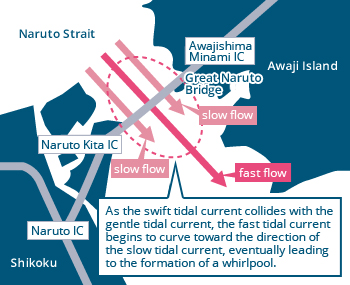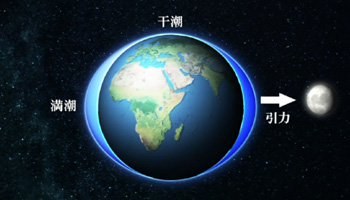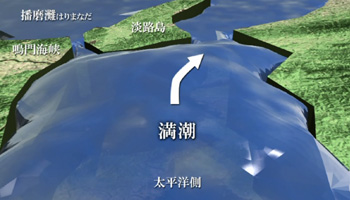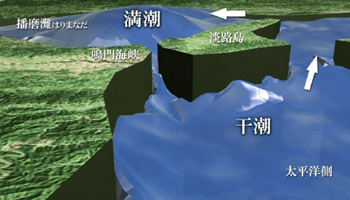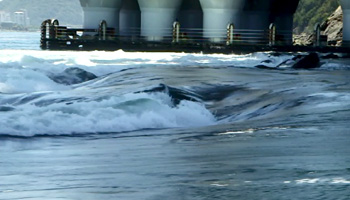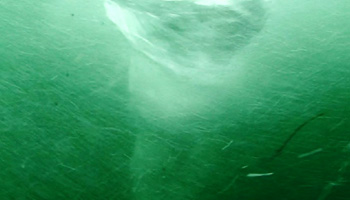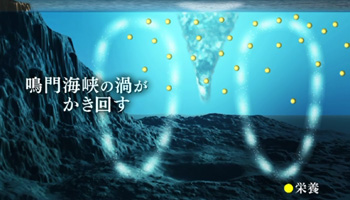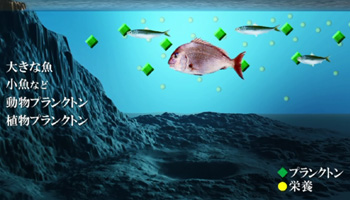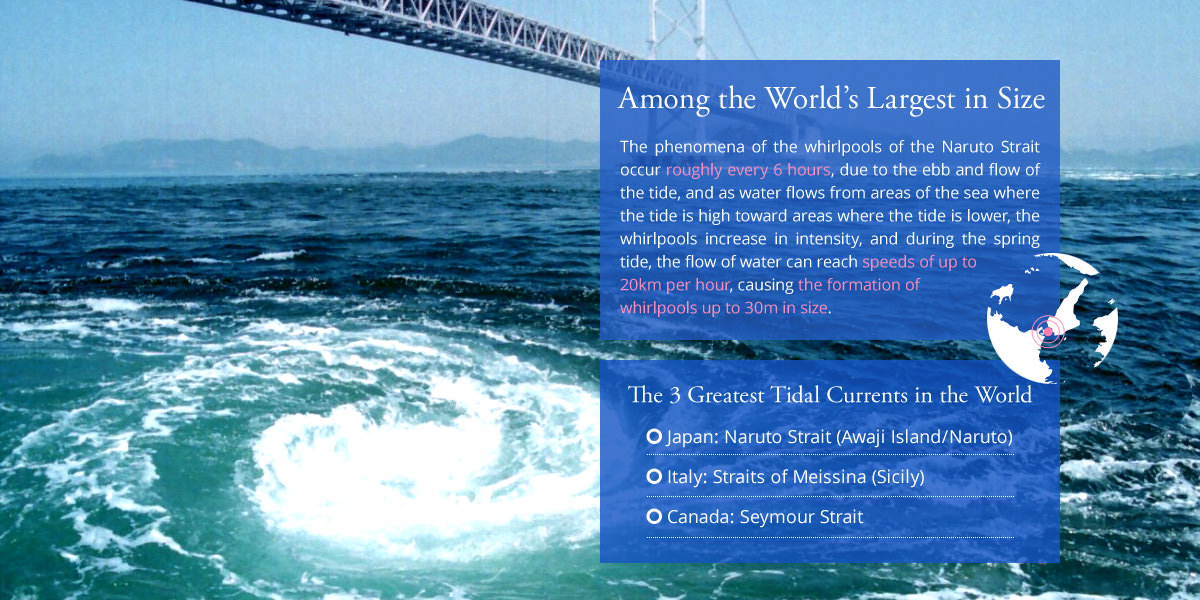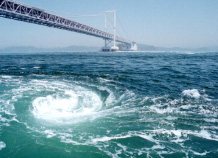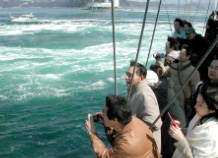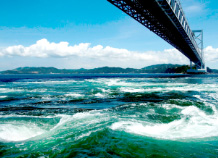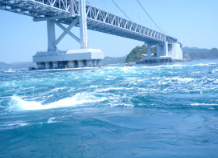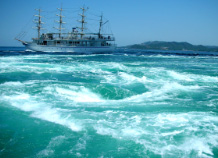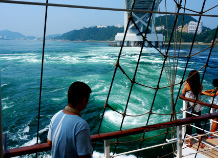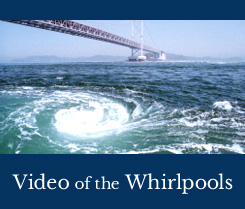The Mechanism of Formation of the Whirlpools of the Naruto Strait
The Ideal Conditions of the Naruto Strait Tidal Current Speeds and Topography of the Sea Bed
The narrow width of the Naruto Strait measures 1.3km, with the cross-sectioned sea floor forming a V-shaped feature with a depth of approximately 100m. As the sea water passes through the strait, the middle of the strait provides very little resistance, allowing the tidal current to flow at rapid speeds.
On the other hand, since the resistance near the opposing shores is high, due to the presence of shoals, etc., the flow of water in those areas is gentle. Due to the difference in speed in these two separate types of tidal currents, a turning force is generated, causing the whirlpools to occur.
When the tide is high at the Harima Sea, the tide flows toward the Kii Channel, and conversely, when the tide is high at the Kii Channel the tide flows back toward the Harima Sea, thus causing whirlpools to occur every 6 hours on both sides of the strait in an alternating manner. Additionally, due to the complex geographical features of the sea bed, it is possible to observe a tidal current flow that appears to be rising directly up from the sea floor.
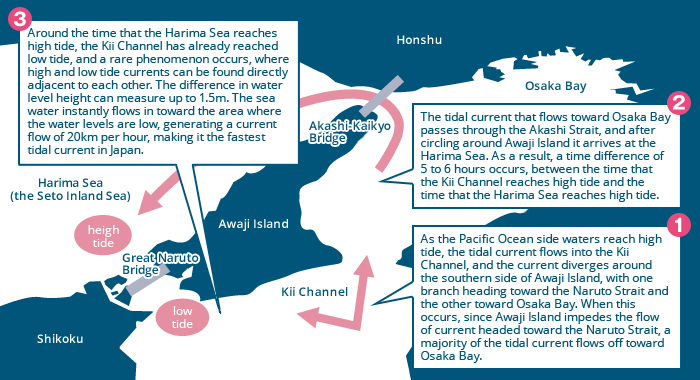
What makes the tidal currents of the Naruto Strait so fast?
1. The Ebb and Flow of the Ocean Tide
The ocean tide ebbs and flows, due to changes in water levels brought about by the gravitational effects of the moon and sun.
2. Unique Topography
As the sea waters are pulled by these forces, high tide, where the water levels are at their highest, and low tide, where the water levels are at their lowest, occur in an alternating cycle, roughly every 6 hours.
However, the Naruto Strait features a unique topography, which cause a marvelous phenomenon, where waters at high tide and low tide levels reside directly adjacent to each other. As the Pacific Ocean side current begins to rise, the current flow travels northward, colliding with the Kii Peninsula, Awaji Island, and Shikoku along the way.
3. The Gap Between Awaji Island and Shikoku
As the gap between Awaji Island and Shikoku measures only 1.3 km and is narrow, the majority of the tidal current flows toward Osaka Bay.
The tidal current that has flowed throughout Osaka Bay then passes through the Akashi Strait and further into the Harima Sea, where the water levels are still low.
4. From Higher to Lower Levels
From the time that the high tide current reaches the southern shores of Awaji Island, until the time that the Seto Inland Sea reaches high tide, there is an interval of approximately 5 to 6 hours.
Once the Seto Inland Sea reaches high tide, the tide is already ebbing at the southern shores of Awaji Island, as it nears low tide.
Since water flows from higher to lower places, the massive amount of sea water that has accumulated in the Seto Inland Sea flows out toward the Pacific Ocean side, where water levels are lower, and it surges toward and flows in at once through the Naruto Strait.
5. The Occurrence of a Fast Tidal Current
Divided by the Naruto Strait, the waters on the Seto Inland Sea side reach high tide, while the waters on the Pacific Ocean side reach low tide, and along this boundary a height difference in sea surface levels occurs.
This height difference can reach a maximum of 1.5m. This difference in elevation results in the occurrence of fast tidal currents.
What is going on underneath the sea surface of a whirlpool?
1. Viewing a Whirlpool from Underwater
Here, you can see a whirlpool as viewed from underwater.
The white foam is formed by oxygen that is pulled in by the whirlpool from the sea surface. The strong pulling-forces of the whirlpool creates a white, tornado-like formation, while at the same time, there also exist forces that spray up water that has been pulled in.
2. A Resource that Keeps the Sea Abundant
Pictured here, are masses of water as they rise to the surface. Both the forces that pull down and the forces that push up help to create the whirlpools, which are an important resource that keeps the sea abundant.
The abundance of the sea is maintained by nutrients in the water, and although most of such nutrients flow in from the rivers, absent of any current, nutrients tend to sink deep in the water. Whirlpools mix these nutrients around so that they spread evenly throughout the water.
3. Abundant Plankton
Because of this, the amount of plankton increases, attracting small fish that feed on plankton, which in turn promotes the growth of larger fish.
4. Whirlpools and their Role in Nurturing the Sea
In this way, the whirlpools of the Naruto Strait are formed by such unique geographical features, and even today, they continue to keep the sea waters fertile.
The Miraculous Whirlpools
